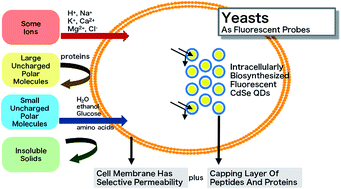Fluorescent yeast containing intracellularly biosynthesized CdSe QDs as a sensitive probe for simple determination of copper(ii) in water and plasma†
Abstract
A simple strategy using CdSe QD-containing yeast as a fluorescent probe was developed for tracing copper(II) (Cu2+) in water and plasma. Nanocrystal CdSe QDs were attentively biosynthesized by Saccharomyces cerevisiae in vivo and were well reserved in the cytoplasm. The yeast membrane, with selective permeability, acted as a semipermeable filter to protect the intrafungal QDs from external interference, for example, from certain ions, peptides, proteins and insoluble solids. Moreover, the as-produced CdSe QDs were capped with cell-derived peptides and proteins, ruling out additional intracellular interference from the cytoplasm, including from some ions, lipids and nucleic acids. With the combination of the dual selective effects of both the yeast membrane and the capping proteins of the QDs, this methodology offered a rapid and reliable method for Cu2+ detection in water and plasma with detection limits as low as 1 μmol L−1 and 2 μmol L−1, respectively. In addition, the presence of the chelating reagent CN− could selectively chelate Cu2+ ions into Cu(CN)n(n−2)−a, resulting in the fluorescence recovery of the QDs, which further reinforced the specificity of Cu2+ detection. These results suggest that this technique via biogenic QD-containing microbes provided great potential for body fluid Cu2+ determination with superior selectivity, reliability and simplicity.


 Please wait while we load your content...
Please wait while we load your content...